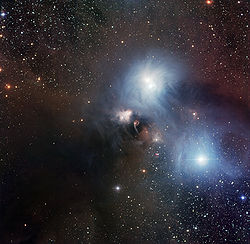Top Qs
Timeline
Chat
Perspective
R Coronae Australis
Star in the constellation Corona Australis From Wikipedia, the free encyclopedia
Remove ads
R Coronae Australis (R CrA) is a variable binary system in the constellation Corona Australis.[2][8] It has varied between magnitudes 10 and 14.36.[10] A small reflection/emission nebula NGC 6729 extends from the star towards SE. It is also the brightest feature of the Coronet Cluster, therefore sometimes called R CrA Cluster.

This star is moving toward the Solar System with a radial velocity of 36 km s−1. It was previously believed that in roughly 222,000 years, this system could have approached within 1.77 light-years (0.54 parsecs) of the Sun. However, the estimate had a considerable margin of error in it.[11] With the release of Gaia DR2, the star was determined to be 4 times further from the Sun than initially believed, constraining the approach to only 111 ± 31 light-years (34.0 ± 9.5 parsecs).[5] Examination of other objects known to be in the same star-forming region gives a distance of 152.9+8.1
−7.3 pc, suggesting an error in the Gaia parallax for R CrA itself.[6]
Johann Friedrich Julius Schmidt discovered that R Coronae Australis is a variable star, in 1865. It appeared with its variable star designation in Annie Jump Cannon's 1907 work Second Catalogue of Variable Stars.[12]
A companion to the star was proposed in 2019 with a mass between 0.1 and 1 Solar masses, depending on the characteristics of the stellar environment, orbiting the primary in 43–47 years.[8] The companion was later directly observed to be a red dwarf with a mass between 0.3 M☉ and 0.55 M☉.[6] It has also been proposed that the primary component is itself a close binary.[7]
Remove ads
References
Wikiwand - on
Seamless Wikipedia browsing. On steroids.
Remove ads

